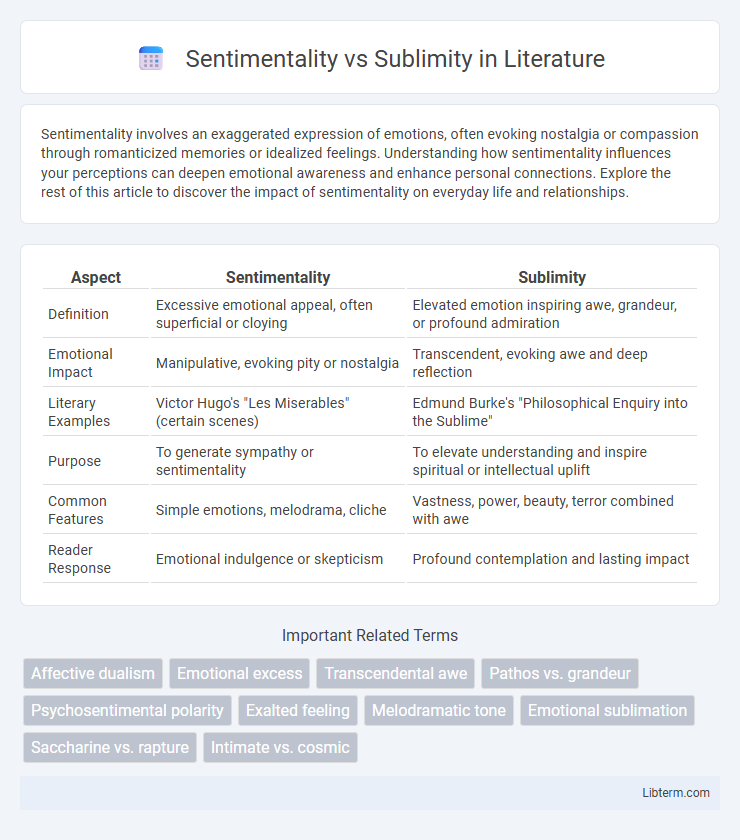Sentimentality involves an exaggerated expression of emotions, often evoking nostalgia or compassion through romanticized memories or idealized feelings. Understanding how sentimentality influences your perceptions can deepen emotional awareness and enhance personal connections. Explore the rest of this article to discover the impact of sentimentality on everyday life and relationships.
Table of Comparison
| Aspect | Sentimentality | Sublimity |
|---|---|---|
| Definition | Excessive emotional appeal, often superficial or cloying | Elevated emotion inspiring awe, grandeur, or profound admiration |
| Emotional Impact | Manipulative, evoking pity or nostalgia | Transcendent, evoking awe and deep reflection |
| Literary Examples | Victor Hugo's "Les Miserables" (certain scenes) | Edmund Burke's "Philosophical Enquiry into the Sublime" |
| Purpose | To generate sympathy or sentimentality | To elevate understanding and inspire spiritual or intellectual uplift |
| Common Features | Simple emotions, melodrama, cliche | Vastness, power, beauty, terror combined with awe |
| Reader Response | Emotional indulgence or skepticism | Profound contemplation and lasting impact |
Defining Sentimentality and Sublimity
Sentimentality is characterized by excessive emotional expression often perceived as insincere or overly simplistic, aiming to evoke superficial feelings rather than profound understanding. Sublimity, in contrast, embodies a powerful, awe-inspiring experience that transcends ordinary emotions, connecting individuals to something greater and evoking deep admiration or reverence. Defining these concepts hinges on sentimentality's appeal to immediate emotions versus sublimity's capacity to inspire lasting, elevated contemplation.
Historical Roots of Sentimentality
Sentimentality traces back to the 18th century Enlightenment and Romanticism, where emotional expression became a valued contrast to rationalism and rigidity. Philosophers like David Hume emphasized sympathy and moral feelings, shaping sentimentality as an ethical and aesthetic response. This historical foundation positioned sentimentality as an accessible emotional appeal, distinct from sublimity's cultivation of awe and grandeur.
The Philosophical Origins of Sublimity
The philosophical origins of sublimity trace back to classical thinkers such as Longinus, whose treatise "On the Sublime" emphasized the power of elevated language and grandeur to evoke awe and profound emotional response beyond mere sentimentality. Unlike sentimentality, which relies on personal, often superficial emotions, sublimity engages the imagination and intellect, linking beauty with vastness, infinity, and the sublime experience of transcendence. This foundational distinction influenced Enlightenment philosophers like Kant, who further explored sublimity as a combination of fear, respect, and admiration rooted in the human capacity to comprehend the infinite.
Emotional Impact: Warmth vs Awe
Sentimentality evokes warmth through familiar emotions and relatable experiences, creating a sense of comfort and nostalgia. Sublimity generates awe by presenting overwhelming grandeur or profound beauty that transcends ordinary feelings, inspiring deep reflection. The emotional impact of sentimentality is intimate and tender, while sublimity produces a powerful, transformative response.
Literary Representations of Sentimentality
Literary representations of sentimentality often emphasize exaggerated emotional expression and moralizing tones, contrasting with sublimity, which evokes awe through grandeur and profound experiences. Sentimentality relies on familiar, tender emotions to elicit sympathy, while sublimity challenges readers by confronting them with overwhelming or transcendent feelings. This distinction shapes readers' emotional engagement, with sentimentality focusing on intimate, personal connections and sublimity invoking a sense of vastness or spiritual elevation.
Sublimity in Art and Literature
Sublimity in art and literature evokes a profound emotional response through grandeur, vastness, or awe-inspiring themes that transcend ordinary experience. It often features elements such as the sublime landscapes of Romantic poetry or the overwhelming power in epic narratives, highlighting the infinite or the divine. This aesthetic prioritizes an overwhelming sense of magnitude and beauty that challenges human comprehension, distinguishing it from mere sentimentality.
Cultural Attitudes Toward Feeling and Transcendence
Cultural attitudes toward sentimentality emphasize emotional expression and personal attachment, often celebrating vulnerability and nostalgic reflection. In contrast, sublimity is associated with awe, grandeur, and the pursuit of transcendence beyond ordinary experience, valued for its capacity to evoke profound spiritual or intellectual responses. These differing perspectives reveal how societies prioritize either intimate emotional connection or the elevation of feeling through encounters with the vast, mysterious, or sublime.
Sentimentality and Modern Media
Sentimentality in modern media often relies on exaggerated emotional cues and nostalgic imagery to evoke a shallow, easily triggered response from audiences. This approach prioritizes surface-level feelings over complex, nuanced storytelling, resulting in content that appeals to fleeting emotions rather than provoking deep reflection. The prevalence of sentimentality can dilute the impact of media, contrasting sharply with sublimity's power to inspire awe and profound insight through transcendental experiences.
Sublimity’s Role in Spiritual and Aesthetic Experience
Sublimity elevates spiritual and aesthetic experiences by transcending ordinary perception and evoking awe through vastness, power, or profound beauty. Unlike sentimentality, which often relies on personal emotion and nostalgia, sublimity connects individuals to a deeper sense of the infinite and the sublime grandeur of existence. This encounter with sublimity fosters a transformative awareness that enriches both the soul and artistic appreciation.
Bridging the Gap: Can Sentimentality and Sublimity Coexist?
Sentimentality, characterized by exaggerated emotional appeal, contrasts with sublimity's evocation of profound awe and transcendence, yet their coexistence emerges in art and literature where heartfelt emotion meets elevated beauty. Bridging this gap requires balancing genuine emotional depth without tipping into mawkishness, enabling sublime experiences rooted in authentic sentiment. Contemporary works demonstrate this fusion by evoking overwhelming feelings that remain nuanced and sincere, proving sentimentality and sublimity can harmoniously intersect.
Sentimentality Infographic

 libterm.com
libterm.com